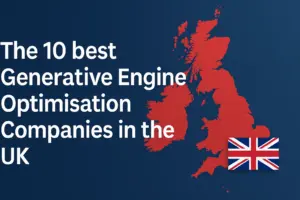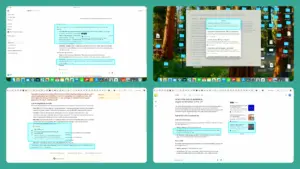Table of Contents
how to get your website cited in AI answers
If you want AI platforms to use your pages as sources—and actually show your brand in their citations—you need content that’s verifiable, structured, recent, and authored by identifiable experts. This guide explains how to apply eleven GEO factors so your pages become the obvious choice for ChatGPT, Perplexity, Microsoft Copilot, and Google’s AI surfaces. We’ve demonstrated this in live tests: #1 in ChatGPT, #1 in Perplexity, #1 in Microsoft Copilot, and #3 in Google AI Mode. See the screen-recorded evidence here: Proof that Generative Engine Optimisation Works. That’s the operational meaning of how to get your website cited in AI answers: build pages AI systems trust enough to name and link.
What “being cited by AI” actually means
- Inclusion: Your page is chosen as a source to help build the AI answer.
- Attribution: Your brand is shown visibly (link card, footnote, reference list).
- Leverage: Even without a click, you gain awareness, assisted conversions, and authority.
The eleven GEO factors that raise your odds of being cited
1) Citations (outbound, to credible sources)
Goal: Prove claims with verifiable evidence.
- Cite primary sources: official docs, regulators, government data, standards, original research.
- Place the citation near the claim it supports; don’t dump them all at the bottom.
- Use descriptive anchors (e.g., “ONS 2024 labour data”, “ICO guidance 2025”).
Why it helps: Models weigh provenance and context; clean citation placement is highly extractable.
2) Statistics (real numbers beat vague claims)
Goal: Quantify key points with current numbers.
- Use fresh, date-stamped data with UK relevance where it matters.
- Add short data notes: method, sample size, time period.
- Include first-party measurements (your tests, audits) where possible.
Why it helps: Dated, transparent stats are quotable, verifiable, and reduce ambiguity.
3) Quotations (authoritative voices)
Goal: Strengthen clarity with short, attributable quotes.
- Quote named experts with role, organisation, and date; keep it under ~40 words.
- Explain the quote’s relevance in your own words immediately after.
- Avoid quote-stuffing; include quotes only when they clarify or settle a point.
Why it helps: Models prefer grounded, attributable statements they can summarise or cite.
4) Fluency (coherent structure that’s easy to extract)
Goal: Help humans and models parse your page quickly.
- Use a logical H2/H3 hierarchy; one idea per paragraph.
- Break density with bullets and short lists; keep paragraphs under ~100 words.
- Use signpost headings that sound like real user questions.
Why it helps: Clean structure increases extractability and reduces hallucination risk.
5) Easy to understand (plain English)
Goal: Reduce ambiguity and cognitive load.
- Define technical terms the first time you use them.
- Include worked examples and short step-by-steps for anything procedural.
- Summarise complex sections up front, then expand.
Why it helps: Clarity improves answer quality and reduces misinterpretation by models.
6) Technical terms and unique terms (use the right vocabulary, plus distinctive detail)
Goal: Cover correct domain terms and add precise, unique phrasing that disambiguates your topic.
- Include standard terminology (e.g., AI Overviews, vector embeddings, schema.org/FAQPage) and natural synonyms people type.
- Add a handful of unique terms (method names, datasets, UK regs), each briefly defined.
- Avoid keyword stuffing; aim for semantic coverage and clarity.
Why it helps: Correct and distinctive vocabulary signals topical depth and reduces overlap with generic pages.
7) Authority (real-world credibility)
Goal: Make identity and track record explicit and verifiable.
- Display author credentials, UK location, and company details.
- Link to proof assets: videos, screen recordings, datasets, public dashboards.
- Use dated reviews or testimonials with identifiable sources.
Why it helps: Engines prefer content with accountable, demonstrable expertise.
8) Schema markup (structured data)
Goal: Explain who said what, when, and how it relates to the page.
- Use Article/BlogPosting with
author,datePublished,dateModified,publisher. - Add FAQPage where you have Q&A; add HowTo for step-by-steps.
- Include BreadcrumbList to clarify page position.
Why it helps: Structured data reduces ambiguity and aids snippet/citation selection.
9) Recency (keep living pages actually alive)
Goal: Stay current when facts and interfaces change.
- Show “Last reviewed” and “Updated” dates near the top or in a meta block.
- Refresh statistics, screenshots, and steps quarterly or on product changes.
- Maintain a simple changelog at the bottom.
Why it helps: Fresh, date-transparent content aligns with recency-sensitive answers.
10) Author bios (who is behind the words)
Goal: Connect claims to a named expert you can verify.
- Add a short bio with headshot, role, and one or two proof points.
- Link to a professional profile (e.g., LinkedIn).
- For sensitive topics, include “Reviewed by” with a second expert.
Why it helps: Strengthens E-E-A-T-style signals and reduces model uncertainty.
11) Source diversity (balance first-party and third-party)
Goal: Demonstrate robustness, not an echo chamber.
- Blend your own evidence (tests, datasets, screenshots) with independent authorities.
- Avoid circular citations where sites quote each other without an original source.
- Present both sides if there’s a debate, then explain your stance.
Why it helps: Balanced corroboration is more likely to be trusted and cited.
Fast checklist you can copy into briefs
- Start with a clear user question; answer it in the first 120 words.
- Add 3–6 citations to authoritative sources; use descriptive anchors.
- Include 2–4 fresh stats with dates and UK relevance where useful.
- Add one short, attributable quote if it clarifies a key point.
- Keep paragraphs short; use bullets for steps or lists.
- Use correct technical terms and a few unique terms (each defined).
- Show an author bio with credentials and a recognisable headshot.
- Add Article + FAQPage schema.
- Display last reviewed and last updated dates.
- Mix first-party proof with third-party confirmations on every page.
Worked example (transform a generic post)
Before: A broad “AI SEO tips” blog with vague assertions, no data, no dates, no evidence.
After:
- Reframe around a specific user question.
- Add two original screenshots or a 30–60 second screen recording.
- Include one UK-relevant stat and one official definition with a straight-to-source link.
- Provide a mini-dataset (even 10–15 rows) and explain what it shows.
- Append a FAQ that matches real follow-ups.
- Wrap with Article + FAQPage schema and a visible author identity block.
Step-by-step playbook for your next page
- Pick a high-intent question. Use customer emails, live chat logs, and sales calls to mirror real wording. Draft the answer first, then write the intro.
- Build the skeleton. H2s are user questions; H3s are steps, examples, definitions. Add a 3–5 bullet summary box at the top.
- Insert first-party proof. Screenshots, short clips, or data snapshots with dates. Host evidence on stable URLs you can update without touching the article.
- Cite third-party authorities. Government, regulators, standards bodies, original research, official product docs. Add one line of context before each link.
- Mark up the page. Article and FAQPage JSON-LD with author, datePublished, dateModified, publisher. BreadcrumbList for clarity.
- Freshen and measure. Add “Last reviewed” with a named reviewer and date. Refresh quarterly or on product changes; keep a short changelog. Track appearances inside AI answers and collect screenshots as proof.
This practical workflow raises the odds of how to get your website cited in AI answers by making evidence easy to verify and extract.
What success looks like (our benchmark)
- #1 in ChatGPT
- #1 in Perplexity
- #1 in Microsoft Copilot
- #3 in Google AI Mode
Proof video with live screen capture and screenshots: https://neuraladx.com/proof-that-generative-engine-optimisation-works-video/
Common mistakes that block AI citations
- Vague claims with no dates or sources.
- Dense walls of text and no subheadings (poor extractability).
- Anonymous authors or unclear credentials.
- Out-of-date screenshots and stale numbers.
- Linking only to low-authority blogs or affiliates.
- No schema markup, so machines can’t easily map questions, answers, authors, and dates.
FAQ’s
How long until I see AI citations?
With first-party proof, clear structure, and schema, many sites see early movement within 4–8 weeks. Competitive topics can take longer.
Do I need backlinks for AI citations?
Backlinks help authority, but on-page evidence, named authorship, and high-quality sources are often decisive for inclusion and visible attribution.
What kind of proof works best?
Short screen recordings, step-by-steps, and mini-datasets with dates. Anything a model can quote, summarise, or show as a link card.
Should I build separate “evidence” pages?
Yes. Host screenshots, data tables, and references on stable URLs; link them from your articles to keep updates simple.
Is schema required?
Not strictly, but Article plus FAQPage makes machine parsing far easier and reduces ambiguity around authors and dates.
Glossary (plain English)
AI citation: When an AI system names and links your page as a source in its answer.
First-party evidence: Proof you created yourself—tests, screenshots, datasets, audits.
Schema (JSON-LD): Structured markup that explains the page to machines (author, dates, Q&A, relationships).
Source diversity: Mixing your own proof with independent, trustworthy references.
Unique terms: Specific phrases that uniquely identify your methods, tools, or datasets (each defined in context).
Final word (the discipline that gets cited)
The pages that win citations are verifiable, well-structured, and recently reviewed, with a human expert standing behind every claim. Apply the eleven factors on every important page, keep your evidence fresh, and record your results. That is how to get your website cited in AI answers: extractable content, visible authorship, real proof, and a clean trail of sources.
Quick recap (for skimmers)
- Answer a real user question up top.
- Mix first-party proof with authoritative third-party sources.
- Use author bio, fresh dates, Article + FAQPage schema.
- Keep paragraphs short and headings specific.
- Refresh quarterly, log changes, and capture screenshots of AI citations.



